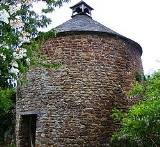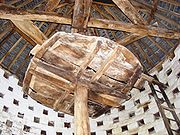
Dunster Dovecote
Encyclopedia
The Dovecote in Dunster
, Somerset
, England was probably built in the late 16th century. It has been designated as a Grade II* listed building and Scheduled Ancient Monument
.
It is situated on Priory Green opposite the Tithe Barn
and close to the walls of the Priory Church of St George
. It is approximately 19 feet (5.8 m) high and 19 feet (5.8 m) in diameter, with walls around 4 feet (1.2 m) thick. There are five hundred and forty nest-holes.
There is no documentary evidence for the dovecote
's date of construction but it some of the architectural features suggest it may have been as long ago as the 14th century. It would originally have belonged to the Benedictine
Priory of Dunster
which was a cell of Bath Abbey
. Domestic Pigeon
s were kept to provide Squabs
a luxury food from the breast meat of young pigeons. Form the 12th century until 1619, only Lords of the Manor and parish priest were allowed to keep them. The priory was abolished in the dissolution of the monasteries
in 1539, and property belonging to it was sold to the Luttrell family of Dunster Castle
.
 In the 18th century the floor level and door were raised among several major alterations. The lower tiers of nest holes were blocked to protect against Brown Rat
In the 18th century the floor level and door were raised among several major alterations. The lower tiers of nest holes were blocked to protect against Brown Rat
s which had arrived in the Britain in 1720 and reached Somerset by 1760. A revolving ladder, known as a "potence", was installed to allow the pigeon keeper to search the nest holes more easily. In the 19th century two feeding platforms were added to the axis of the revolving ladder.
When the Dunster Castle estate was sold the Dovecote was bought by the Parochial church council
and opened to the public. Extensive repairs were undertaken in 1989.
Dunster
Dunster is a village and civil parish in west Somerset, England, situated on the Bristol Channel coast south-southeast of Minehead and northwest of Taunton. The village has a population of 862 .The village has numerous restaurants and three pubs...
, Somerset
Somerset
The ceremonial and non-metropolitan county of Somerset in South West England borders Bristol and Gloucestershire to the north, Wiltshire to the east, Dorset to the south-east, and Devon to the south-west. It is partly bounded to the north and west by the Bristol Channel and the estuary of the...
, England was probably built in the late 16th century. It has been designated as a Grade II* listed building and Scheduled Ancient Monument
Scheduled Ancient Monument
In the United Kingdom, a scheduled monument is a 'nationally important' archaeological site or historic building, given protection against unauthorized change. The various pieces of legislation used for legally protecting heritage assets from damage and destruction are grouped under the term...
.
It is situated on Priory Green opposite the Tithe Barn
Tithe Barn, Dunster
The Tithe Barn is a 14th century tithe barn in Dunster, Somerset, England.It has a cruciform plan. The east front has central double doors in heavy oak with a chamfered frame. It is a grade II listed building....
and close to the walls of the Priory Church of St George
Priory Church of St George, Dunster
The Priory Church of St George in Dunster, Somerset, England is predominantly 15th century with evidence of 12th and 13th century work. It has been designated as a Grade I listed building.-History:...
. It is approximately 19 feet (5.8 m) high and 19 feet (5.8 m) in diameter, with walls around 4 feet (1.2 m) thick. There are five hundred and forty nest-holes.
There is no documentary evidence for the dovecote
Dovecote
A dovecote or dovecot is a structure intended to house pigeons or doves. Dovecotes may be square or circular free-standing structures or built into the end of a house or barn. They generally contain pigeonholes for the birds to nest. Pigeons and doves were an important food source historically in...
's date of construction but it some of the architectural features suggest it may have been as long ago as the 14th century. It would originally have belonged to the Benedictine
Benedictine
Benedictine refers to the spirituality and consecrated life in accordance with the Rule of St Benedict, written by Benedict of Nursia in the sixth century for the cenobitic communities he founded in central Italy. The most notable of these is Monte Cassino, the first monastery founded by Benedict...
Priory of Dunster
Dunster Priory
Dunster Priory was established as a Benedictine monastery around 1100 in Dunster, Somerset, England.The first church in Dunster was built by William de Mohun who gave the church and the tithes of several manors and two fisheries, to the Benedictine Abbey at Bath. The priory, which was situated...
which was a cell of Bath Abbey
Bath Abbey
The Abbey Church of Saint Peter and Saint Paul, Bath, commonly known as Bath Abbey, is an Anglican parish church and a former Benedictine monastery in Bath, Somerset, England...
. Domestic Pigeon
Domestic Pigeon
The Domestic Pigeon was derived from the Rock Pigeon. The Rock Pigeon is the world's oldest domesticated bird. Mesopotamian cuneiform tablets mention the domestication of pigeons more than 5,000 years ago, as do Egyptian hieroglyphics.Research suggests that domestication of pigeons was as early as...
s were kept to provide Squabs
Squab (food)
In culinary terminology, squab is a young domestic pigeon or its meat. The meat is widely described as tasting like dark chicken. The term is probably of Scandinavian origin; the Swedish word skvabb means "loose, fat flesh". It formerly applied to all dove and pigeon species, such as the Wood...
a luxury food from the breast meat of young pigeons. Form the 12th century until 1619, only Lords of the Manor and parish priest were allowed to keep them. The priory was abolished in the dissolution of the monasteries
Dissolution of the Monasteries
The Dissolution of the Monasteries, sometimes referred to as the Suppression of the Monasteries, was the set of administrative and legal processes between 1536 and 1541 by which Henry VIII disbanded monasteries, priories, convents and friaries in England, Wales and Ireland; appropriated their...
in 1539, and property belonging to it was sold to the Luttrell family of Dunster Castle
Dunster Castle
Dunster Castle is a former motte and bailey castle, now a country house, in the village of Dunster, Somerset, England. The castle lies on the top of a steep hill called the Tor, and has been fortified since the late Anglo-Saxon period. After the Norman conquest of England in the 11th century,...
.

Brown Rat
The brown rat, common rat, sewer rat, Hanover rat, Norway rat, Brown Norway rat, Norwegian rat, or wharf rat is one of the best known and most common rats....
s which had arrived in the Britain in 1720 and reached Somerset by 1760. A revolving ladder, known as a "potence", was installed to allow the pigeon keeper to search the nest holes more easily. In the 19th century two feeding platforms were added to the axis of the revolving ladder.
When the Dunster Castle estate was sold the Dovecote was bought by the Parochial church council
Parochial Church Council
The parochial church council , is the executive body of a Church of England parish.-Powers and duties:Two Acts of Parliament define the powers and duties of PCCs...
and opened to the public. Extensive repairs were undertaken in 1989.

